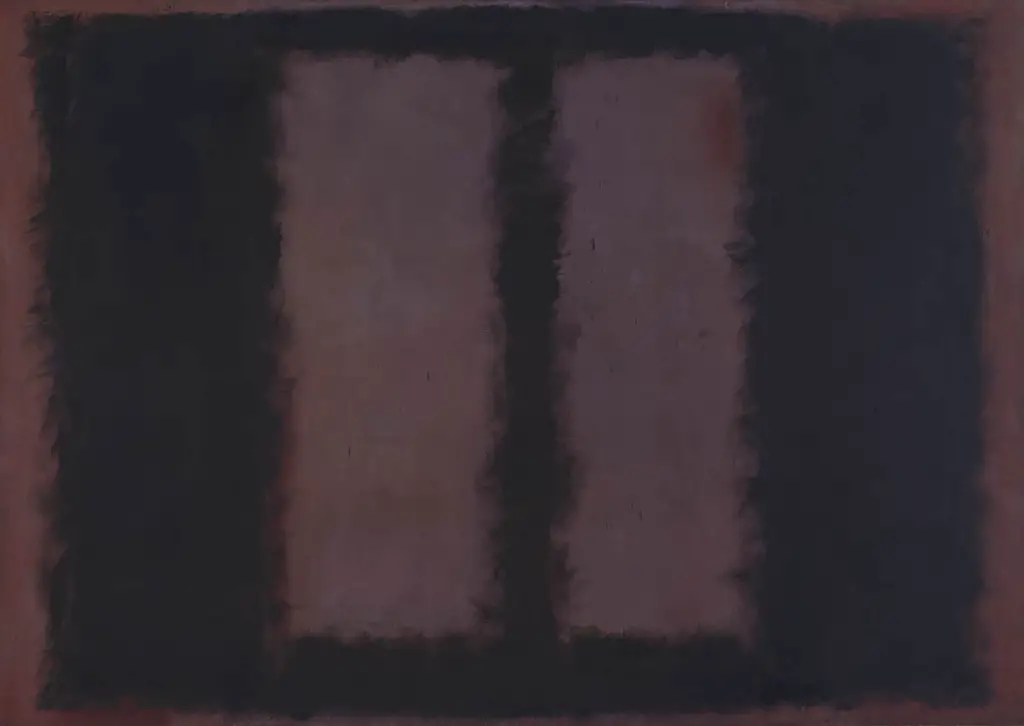The Four Seasons, one of the smartest restaurants in the city, is in the Seagram Building, a celebrated classic modern skyscraper on Park Avenue designed by Mies van der Rohe and Philip Johnson. As he worked on the commission Rothko's conception of the scheme became more and more sombre and he abandoned the first series as being too light in mood. He then adopted a palette of black on maroon and dark red on maroon, and compositional structures of open, rectangular, window-like forms, rather than his usual arrangement of uniform rectangular patches, used for the first series. He later said, "...After I had been at work for some time I realised that I was much influenced subconsciously by Michelangelo's walls in the staircase room of the Medicean Library in Florence. He achieved just the kind of feeling I'm after..."
The reference is to the motif of heavily pedimented blank stone windows set in the white walls of the ante-room of the Laurentian Library, which together with other architectural effects created there by Michelangelo, create an atmosphere noted for its oppressive, almost frightening, grandeur. In the end Rothko decided to withhold his murals from installation in the Four Seasons, his reported reason being that he did not wish his pictures to be a background to the eating of the privileged. Clearly, in any case, he had created a series of paintings whose particularly solemn and meditative character ill-suited a fashionable restaurant. Most modern artists from the 1940s onwards have been fairly left-leaning in political output, though from midle-class roots at the same time.
It was these paintings, seen in Rothko's studio in 1960 by John and Dominique de Menu, that prompted these art lovers to commission Rothko to decorate a chapel that they would build in Houston, Texas. The project, described by Rothko as the most important of his life, was completed just before his death in 1970. In 1965, influenced by the idea that his pictures would be in the same building as Turner, Rothko suggested making a gift to the Tate Gallery. The works would be from the Four Seasons series and would be chosen by the artist to form a coherent group, to be shown in a space on their own. The gift was finalised in 1969 and the paintings arrived in 1970. On the day of their arrival, as the huge crates were being unpacked to reveal their contents, a cable was received from New York announcing that Rothko had been found dead in his studio.
A large amount of research was completed on the working processes of the artist for this painting. The 1958 mural was defaced in 2012 in such a dramatic way that, sadly, a huge restoration project was required in order to restore it to it's former glory. Thankfully, that has now been complete. The researchers created their own replica of the painting using the same techniques as Rothko in order to be able to test different fixes to it, before then carrying out the best solution on the damaged original. Ultimately this process worked, but it took many months and cost several hundred thousands of pounds in order to each a satisfactory conclusion. The culprit served around 18 months in prison for his selfish and bizarre attack. Such vandalism is not uncommon within the art world, generally involving the mentally ill or politically extreme.
Early research has revealed the use of glue, synthetic resin and egg alongside oil paint from Rothko and so they set about using those same materials for their experimental copy. The artist himself would use these various items in order to produce a combination and variety of finishes upon his rectangular shapes, much of which you would only be able to see up close. This painting, for example, is nearly four metres tall, and so to reduce it down to a small photograph for the internet, of course, most of the fine detail would be lost. That also explains why many have a limited knowledge of just what Rothko paintings involve, with most being unable to see any of them in person. The artist eventually decided against having some of his work handed over to those who had commissioned it, such was his right.
The item here is owned by the Tate Modern in London and this venue continues to be one of the finest modern art galleries in the world, competing strongly with major institutions in North America and mainland Europe. Visitors to the location will normally be able to check out some major exhibitions which rotate around the year, though the permanent collection remains highly impressive, with some of the highlights being A Young Lady's Adventure by Paul Klee, one of the Monet Water-Lilies series, Bathers at Moritzburg by Kirchner and also a number of pieces from Georges Braques and Robert Delaunay. The huge display capacity allows several exhibitions at a time and they have also recently extended the building substantially to increase the available facilities.


